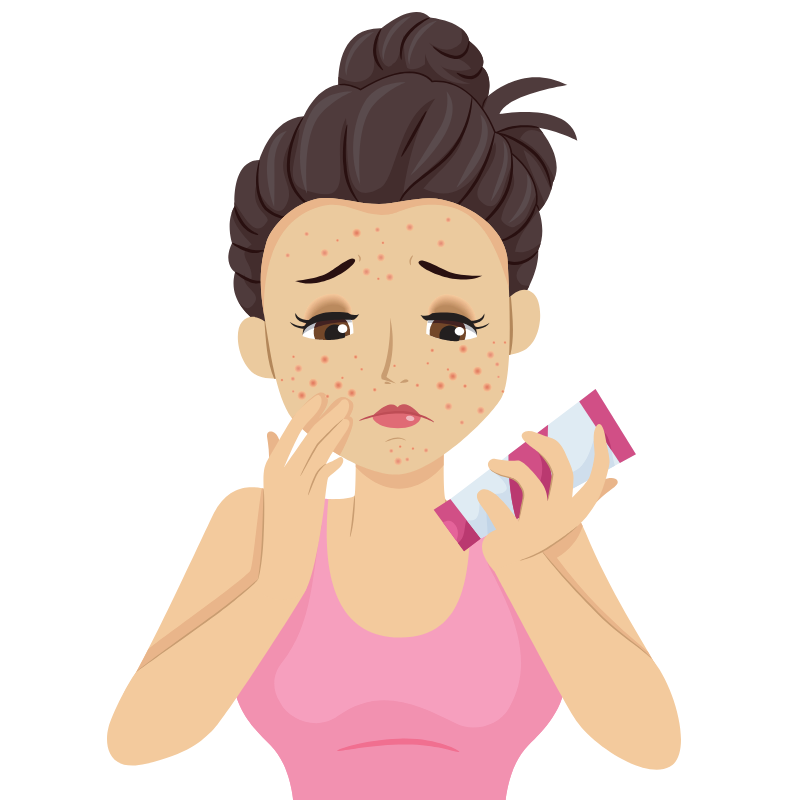Food as Medicine for Dry and Inflamed Vata-Pitta skin.
According to Ayurveda, dry skin is a manifestation of an imbalance in Vata dosha, while inflamed skin, including acne, indicates an imbalance in Pitta energy.
There are no good or wrong skin types. Each skin type, when healthy, has its beauty. A healthy combination of Vata and Pitta in the skin brings a beautiful glow of Pitta to the elegancy of Vata. However, problems start piling up when both energies get out of balance. You probably already know that Vata energy is dry, mobile, cold, rough, and sharp due to air and ether elements contained in the dosha. And qualities of Pitta energy are hot, unstable, slightly moist, and sharp due to the predominant fire element mixed with a smaller amount of water. Thus, you see that the Vata-Pitta combination is quite complicated. On the one hand, Vata and Pitta doshas share a sharp quality and lack the earth element; on the other hand, the qualities of pairs hot/cold and moist/dry are opposite. This conflict might be beneficial and vice versa. The bright side of the Vata-Pitta combination is in neutralizing the opposite qualities to prevent Vata from being too cold and dry or Pitta from being too hot or oily. The challenging side of this combination is the ever-changing Vata component due to the mobile quality of the air element residing in Vata. Vata is a tricky energy that pushes other doshas (Pitta and Kapha) out of their locations. Even when we see distinct features of Pitta imbalance as flushing skin, rosacea, or acne, the underlying cause is the Vata outrage. Let me explain how Vata and Pitta manifest in Vata-Pitta (more Vata than Pitta) and Pitta-Vata (more Pitta than Vata) combinations.
Vata-Pitta Combination
Common Vata-Pitta skin problems are dry acne without cysts, dry rashes, dry red patches, slightly inflamed eczema, slightly inflamed psoriasis, hormonal acne, milia, pigmentation, discoloration, and purple circles under the eyes. The Vata-Pitta mix has more air and ether elements than fire and water. This means that the skin is drier (though not as dry as in a pure Vata case) and prone to flushing and dry acne. So, the main mix is dryness and heat. From an Ayurvedic perspective, all health problems start in the digestive tract. Thus, we must be sure that we create a normal (not overheated) and moist environment in the digestive system. To alleviate excess Vata and Pitta, hot, light, and dry qualities should be reduced. We can do this by adding more cool, heavy, and moist qualities.
Pitta-Vata Combination
Common Pitta-Vata skin problems are similar to the Vata-Pitta type but with more inflamed and less dry skin conditions. In this combination, the body and the skin have more fire and less air and ether elements. There is more inflammation in the body and the skin. So, the solution is to work to reduce inflammation.
Food choices for Vata-Pitta combination
As we talk about food choices, let’s take a closer look at the qualities of foods that help balance the doshas. One of the basic concepts in Ayurvedic nutrition is the concept of six tastes that include sweet, salty, sour, pungent, astringent, and bitter.
The best taste for balancing both Vata and Pitta is the sweet taste.
Sweet taste is made up of the earth and water elements. Thus, the sweet taste is heavy, moist, cool, smooth, soft, and nourishing. All the qualities are very beneficial for dry Vata and fiery Pitta energies.
It is important to notice that refined sugar and a high dosage of natural sugars are not good for any dosha, including Pitta and Vata. Moreover, they seriously aggravate Pitta energy by creating inflammation in the body. And you know that Pitta is the energy causing any inflammation.
Examples of a beneficial sweet taste for the combination of Vata and Pitta include grains, meat, fish, oils, nuts, and seeds.
Five Other Tastes: Astringent, Sour, Salty, Pungent, and Bitter
The astringent taste is made up of the earth and air elements; thus, its qualities are dry and cold. The earth element is needed for both Vata and Pitta. However, the dry quality is aggravating for Vata.
If you have more Vata than Pitta imbalance, be cautious. Too much astringent taste might aggravate the condition. It happens because extreme dryness impairs all mucous membranes in the body, eventually resulting in dry skin and an impaired skin barrier, which protects the skin from bacteria and other environmental challenges.
Examples of the astringent taste include most beans, celery, cranberries, and pomegranate.
The sour taste primarily consists of fire, earth elements, and a little water. These elements make the sour taste heavy and stable due to the earth element and hot and slightly moist due to the fire element. Consuming sour foods may result in discomfort, such as heartburn and indigestion, as these foods can irritate the stomach's mucous lining. When the stomach and small intestine linings become inflamed, they are unable to produce the necessary enzymes for proper digestion. Without sufficient digestive juices, the foods we consume cannot be fully broken down, leading to the buildup of undigested food molecules. These large molecules can turn into toxins and spread throughout the body, settling in vulnerable organs. The combination of toxins and internal heat can cause inflammation in these organs, including the skin.
So, if you have more Pitta than Vata imbalance, be cautious. Be sure that you have enough sweet taste in the meal (rice, bread, etc) to counterbalance the acidity of sour foods. Examples of the sour taste are sour fruits, sour tomatoes, fermented foods such as yogurt and kombucha, and wines.
The salty taste is primarily made up of water and fire elements. Due to this, the qualities of the salty taste are moist, warm, and relatively heavy (though not as heavy as the sweet taste). Like the sour taste, the salty taste is controversial for Vata -Pitta combination due to the qualities of water and fire elements contained in it. The water element is moist, which is needed to bring moisture to dry Vata conditions. When there is an excess of salty foods in Pitta's diet, this gives rise to the hot quality of the salty taste, aggravating Pitta. Also, excess salt turns its moist quality into a dry one. So, be wise. When you feel that you have Vata-Pitta condition (more Vata than Pitta), you can consume moderate amounts of salty foods. When there is more inflammation, reduce salty foods to keep the hot quality of Pitta under control. Examples of the salty taste are seaweed, seafood, and any salts.
The pungent taste is made up of fire and air elements, and its qualities are hot, light, mobile, and dry. The pungent taste is the hottest among other tastes; thus, excess of hot spices in a diet will lead to inflammation in the gut. Due to the air element, the pungent taste is dry, thus aggravating the ever-dry Vata. As you see, the pungent taste is the most damaging for Vata and Pitta mix. Dry ginger, raw garlic and onions, chili, black pepper, and alcohol burn stomach and small intestine linings, making them inflamed. This interferes with digestion and nutrient absorption leading to the formation of toxins, which, when mixed with fire, lead to inflammation in different organs. The worse the inflammation, the more critical it is to eliminate the foods and beverages mentioned above from the diet.
The bitter taste comprises air and ether elements with the qualities of coldness, lightness, mobility, and dryness. The bitter taste is the coldest among other tastes; thus, this taste is the best to counter the heat of elevated Pitta. So, almost all anti-inflammatory substances have a bitter taste. These substances clean the liver, improve bile flow, and clean blood vessels and blood, thus reducing inflammation. Bitter foods are our best choice for inflamed acne lesions and redness. So, you take foods with a bitter taste when you have more inflammation and not too much dryness. The bitter taste is also drying due to air and ether elements, which helps when acne skin is oily. However, when a person has more Vata than Pitta (dry, inflamed skin), too much bitter taste might aggravate the condition leading to excess dryness. Examples of foods with a bitter taste include spinach, cilantro, kale, lettuce, and dandelion.

